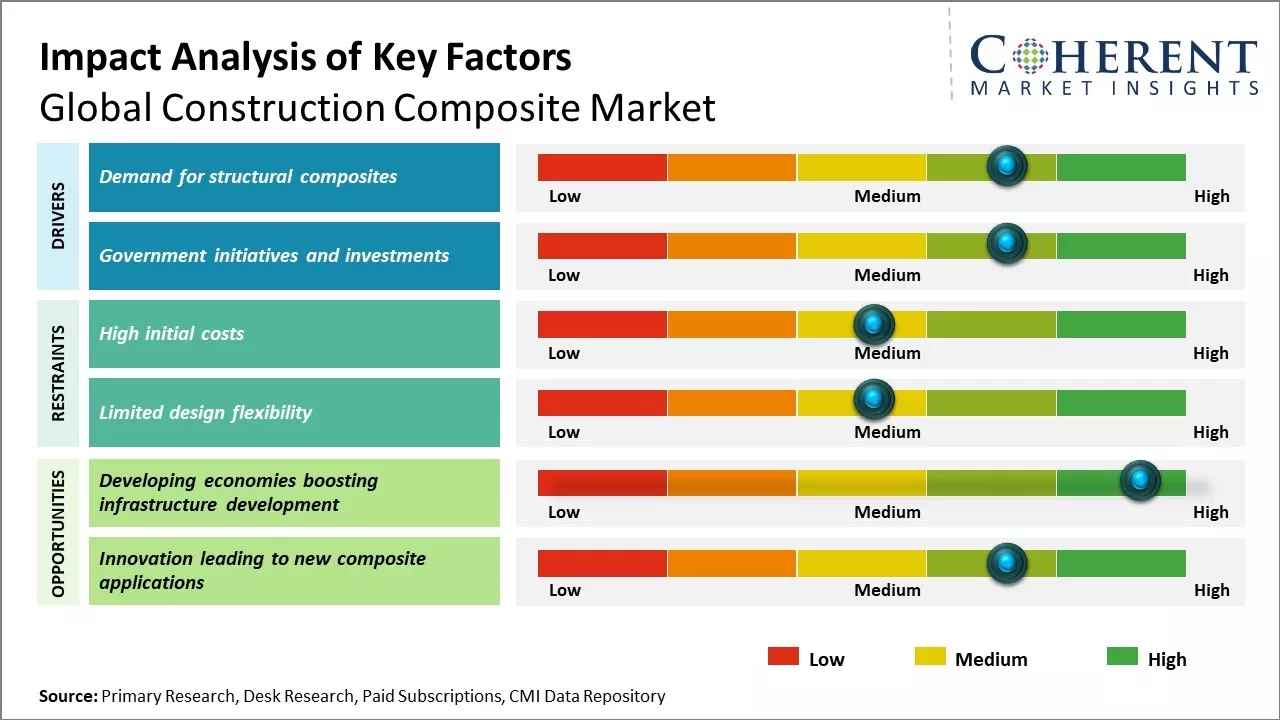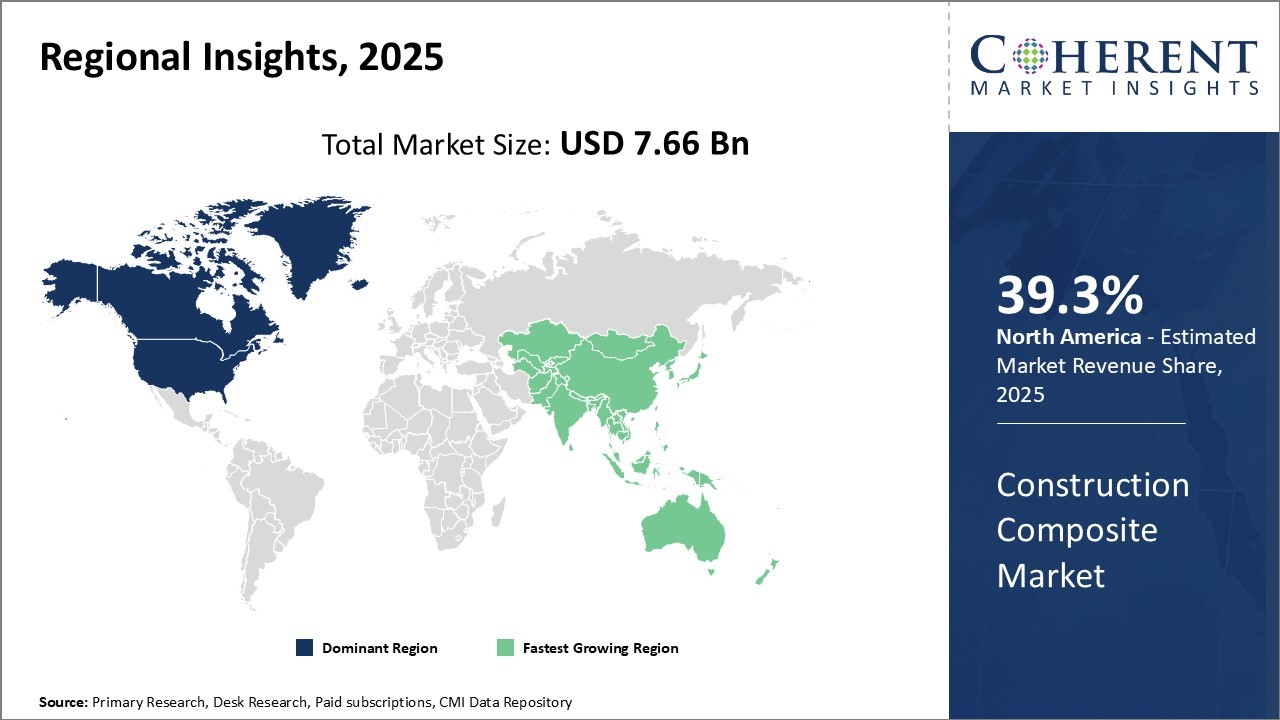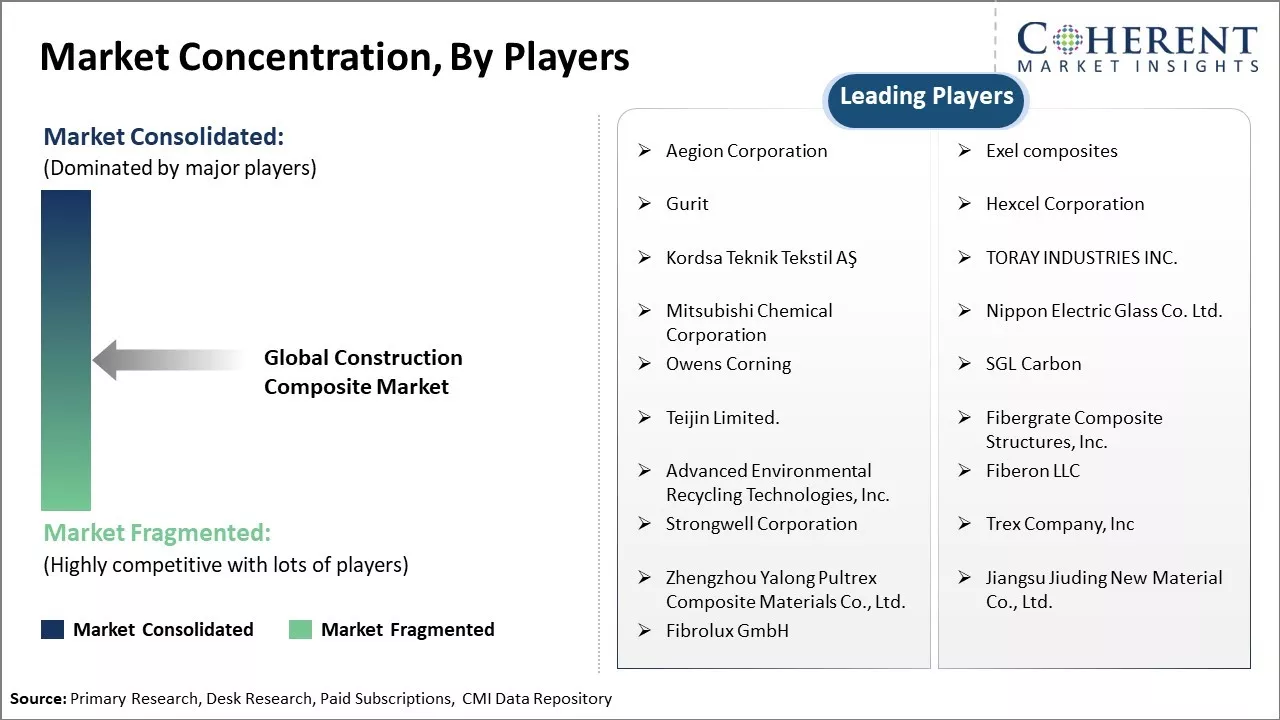The construction composite market is estimated to be valued at USD 7.66 Bn in 2025 and is expected to reach USD 11.38 Bn by 2032, exhibiting a compound annual growth rate (CAGR) of 5.8% from 2025 to 2032.

To learn more about this report, Download Free Sample
The construction composite market is witnessing steady growth, driven by rising demand for lightweight, durable, and corrosion-resistant materials. Composites are increasingly replacing traditional materials like steel and concrete due to their high strength-to-weight ratio and low maintenance needs.
These materials are ideal for residential, commercial, and infrastructure applications, such as bridges and structural supports. Growing emphasis on sustainability and efficiency is further boosting construction composite market demand, supported by advancements in material technology and wider adoption in both new builds and renovation projects.
|
Current Event |
Description and its Impact |
|
Regional Economic and Industrial Policies |
|
|
Technological Innovations in Material Science |
|
Uncover macros and micros vetted on 75+ parameters: Get instant access to report
While end users acknowledge the strength-to-weight ratio and corrosion resistance of composite materials (e.g., fiber-reinforced polymers), many report variability in long-term performance across different environmental conditions. Concerns include:
Unmet Need: Development of composites with enhanced thermal and fire resistance, and standardized long-term durability data to support lifecycle assessments.
Several users cite issues during the handling and installation of composite components, particularly in retrofitting projects or complex geometries.
Unmet Need: Improved ease of installation, better on-site adaptability, and training resources or modular composite systems to streamline deployment.
Although composites offer lifecycle cost benefits due to reduced maintenance, their higher initial material and fabrication costs remain a barrier to adoption.
Unmet Need: More competitive pricing structures, clearer return-on-investment models, and cost-effective manufacturing techniques (e.g., automation, additive manufacturing).
Users also note constraints related to supply chain flexibility and the ability to tailor composite solutions to project-specific requirements.
Unmet Need: Regionalized production, quicker customization options, and greater supply chain resilience.
In terms of resin type, polyester resin segment is expected to contribute 58.4% share of the market in 2025, owing to its superior properties. Polyester resin is cost effective compared to other resins, yet durable and easy to process. It offers high strength-to-weight ratio and corrosion resistance properties essential for the construction industry. Polyester resin constructions are known to withstand extreme weather conditions and perform well over long lifespan of infrastructure. The resin also allows for quick manufacturing cycles and higher production volumes, gaining popularity among construction giants. Its versatility allows use in diverse construction applications from wind turbines and bridges to pipes and transportation infrastructure. Growing demand for cost-competitive and durable construction materials is expected to further propel the polyester resin demand.
In June 2025, ZhongTritium, a major unsaturated polyester resin (UPR) producer based on China, expanded its global footprint with two production plants delivering a combined 500 ktpa capacity and a third 200 ktpa facility under construction. Backed by a CNAS‑accredited R&D center, the company offers a diverse UPR portfolio across construction, marine, automotive, sanitary ware and FRP industries. This is further accelerating the construction composite market demand.
In the fiber type segment, carbon fibers segment is expected to contribute 33.8% of the market share in 2025 owing to their unmatched mechanical properties. Carbon fibers are lightweight yet very strong, and also do not corrode. They provide stiffness and strength that construction structures need to last for decades. Carbon fiber reinforcements enable designing lighter and sleeker structures without compromising on load bearing capacity. This is highly valued in modern infrastructure development focusing on sustainability. Carbon fibers are increasingly used in high-strength applications such as bridges and tunnels where safety is critical. Rapid adoption of advanced composite materials is expected to drive the demand for carbon fiber reinforcements in the coming years.
In October 2024, the German-built BW 399c road bridge on the A3 near Nuremberg has won the prestigious German Steel Construction Engineering Award 2024, thanks to its pioneering use of carbon fiber reinforcement. It is designed by Leonhardt, Andrä und Partner, this 64‑meter structure is Europe’s first road bridge to feature an orthotropic composite slab reinforced with 50k SIGRAFIL® carbon fibers from SGL Carbon.
In terms of end-use sectors, the housing segment is expected to contribute 34.9% share to the construction composite market in 2025. Housing developers are adopting composite materials to meet growing demand for affordable housing while maintaining structural integrity. Composites allow for quicker construction cycles and mass production of lightweight housing modules. Their durability also reduces long-term maintenance costs over concrete. Major attention is being given to composite paneling and framing systems that provide insulation and weather resistance. Various composites trials are underway to 3D print complete houses affordably. This is expected to advance the housing industry by leveraging composite materials for low-cost yet high-quality housing solutions.
In February 2025, Avient Corporation launched Hammerhead™ FR Flame Retardant Composite Panels, an industry‑first thermoplastic composite sandwich board with built‑in flame resistance, it has no additional coatings required. Debuting at the NAHB International Builders’ Show in Las Vegas. The panels meet ASTM E84 Class A fire‑spread and smoke‑density ratings and have passed NFPA 286 corner room burn testing. Measuring up to 10 ft in width and nearly unlimited length, the lightweight panels are designed for modular walls, floors, and ceilings, offering superior resistance to moisture, UV, chemicals, and corrosion. They bond easily, are paintable, and significantly cut installation time and costs.

To learn more about this report, Download Free Sample
North America has established itself as the dominant regional market for construction composites. The region is expected to account for 39.3% of the market share in 2025. This can largely be attributed to the region's well-developed construction industry and supportive infrastructure. A notable example is the use of Fiber Reinforced Polymer (FRP) composites in the I-90 bridge rehabilitation project in New York, where lightweight, corrosion-resistant FRP panels replaced aging concrete decks with cutting installation time and extending lifespan. Similarly, the City of Los Angeles adopted composite utility poles, manufactured by companies like RS Technologies, to enhance wildfire resilience.
Over the years, North America has witnessed rising adoption of advanced composite materials like Fiber Reinforced Polymer (FRP) in various infrastructure projects. Government incentives for the use of sustainable building materials and green building codes have encouraged contractors to use composites in place of concrete and steel.
Countries like the U.S. and Canada have a strong presence of leading composite manufacturers like Owens Corning and Hexcel are expanding their composite portfolios with fire-retardant, UV-stable, and recyclable solutions for commercial and residential buildings. In March 2025, Owens Corning launched a next-generation glass fiber composite aimed at improving insulation and energy efficiency in modular construction.
Backed by extensive R&D investments and a wide domestic and international distribution network, North American producers are driving innovation and accessibility in construction composites which is significantly solidifying the region’s market dominance.
Asia Pacific has emerged as the fastest growing regional market for construction composites globally. Rapid urbanization and infrastructure development activities across countries like China, India, and South East Asian nations are major demand drivers. These economies are witnessing large-scale investments in highways, bridges, mass transit systems, and commercial buildings. This has increased the consumption of composite materials for applications like signage, exterior paneling, and railings. China, in particular, has stepped up its infrastructure push under the Belt and Road initiative. Many new construction projects incorporate composite design elements to reduce costs and build efficiently. Local composite manufacturers are increasingly partnering with international suppliers to boost local production capacities. This will help reduce import dependence and meet the gigantic projected demand from the construction industry. Asia Pacific's growth is further aided by relatively cheaper labor and raw material costs compared to developed markets.
In April 2025, Viva Composite Panel Pvt. Ltd., Asia’s largest metal composite panel (MCP) manufacturer, inaugurated a state‑of‑the‑art Experience Centre at Lumbini Jewel Mall, Banjara Hills, Hydrabad. It is designed provide architects, designers, and end-users with an immersive experience of Viva’s cutting-edge product offerings.
The United States is one of the leading countries in the construction composite market, driven by widespread application across civil, commercial, and public infrastructure projects. Composites are extensively used in bridges, highways, commercial buildings, and the retrofitting of aging infrastructure, where traditional materials like steel and concrete are being replaced by fiber-reinforced polymers (FRPs) and other advanced composites.
Other key driver of composite adoption in the U.S. is the need for lightweight, corrosion-resistant materials that improve structural performance and reduce maintenance costs. Composites excel in harsh environments like coastal bridges and wastewater facilities, offering superior durability over traditional materials. Additionally, federal initiatives like the Bipartisan Infrastructure Law are boosting investment in roads, bridges, and transit, promoting the use of innovative, long-lasting materials—further fueling the construction composite market demand.
China is one of the fastest-growing markets for construction composites, fueled by its rapid urbanization, large-scale infrastructure expansion, and emphasis on smart, sustainable development. As the country continues to urbanize, with millions of people migrating to cities each year, there is a significant need for high-rise residential buildings, commercial complexes, transportation systems, and public infrastructure. This demand is placing pressure on the construction industry to adopt materials that are not only strong and durable but also lightweight, corrosion-resistant, and easy to install, qualities that construction composites offer.
In China, fiber-reinforced polymers (FRPs) and composite panels are increasingly used in bridges, facades, roofing, and cladding due to their durability and resistance to extreme weather and pollution. Government investments in smart cities and green buildings are accelerating the shift toward these advanced materials, aligning with national goals for energy efficiency and sustainability.
For instance, Construction has begun on China’s first manufacturing park dedicated to ceramic-based composite materials at the Xi’an Aviation Base. These advanced composites are known for their high-temperature resistance, durability, and oxidation resistance. They are already being used in a variety of high-performance applications, including aircraft and aerospace engines, heat-resistant aircraft structures, lightweight components for space missions, braking systems, nuclear energy, and photovoltaic electronics. This is further accelerating the construction composite material market share.

To learn more about this report, Download Free Sample
| Report Coverage | Details | ||
|---|---|---|---|
| Base Year: | 2024 | Market Size in 2025: | USD 7.66 Bn |
| Historical Data for: | 2020 To 2024 | Forecast Period: | 2025 To 2032 |
| Forecast Period 2025 to 2032 CAGR: | 5.8% | 2032 Value Projection: | USD 11.38 Bn |
| Geographies covered: |
|
||
| Segments covered: |
|
||
| Companies covered: |
Aegion Corporation, Exel composites, Gurit, Hexcel Corporation, Kordsa Teknik Tekstil AÅž, TORAY INDUSTRIES INC., Mitsubishi Chemical Corporation, Nippon Electric Glass Co. Ltd., Owens Corning, SGL Carbon, Teijin Limited., Fibergrate Composite Structures, Inc., Advanced Environmental Recycling Technologies, Inc., Fiberon LLC, Strongwell Corporation, Trex Company, Inc, Zhengzhou Yalong Pultrex Composite Materials Co., Ltd., Jiangsu Jiuding New Material Co., Ltd., and Fibrolux GmbH |
||
| Growth Drivers: |
|
||
| Restraints & Challenges: |
|
||
Uncover macros and micros vetted on 75+ parameters: Get instant access to report
The construction industry has been witnessing high demand for structural composites owing to their versatile properties and wide application areas. Composite materials such as Fiber Reinforced Polymer (FRP), Glass Fiber Reinforced Polymer (GFRP), and Carbon Fiber Reinforced Polymer (CFRP) composites are increasingly replacing traditional construction materials like concrete, wood, and steel in several load bearing applications. Composites offer superior physical and mechanical properties like high strength to weight ratio, resistance to corrosion, and weathering compared to conventional materials. Their light weight enables easy transportation and handling at construction sites.
Composites are highly suitable for structures that require low maintenance and minimal repairs such as bridges, rail infrastructure, commercial buildings, etc. The use of composite materials helps reduce reinforcement corrosion which is a major issue plaguing concrete structures. Fiber reinforced polymer rebars have higher tensile strength than steel and do not corrode even under severe weather conditions. This promotes longer service life of structures with lower maintenance costs. Composites also provide designers greater freedom due to their customizable properties support innovative designs that were not possible with other materials. Several highway authorities and public works departments are actively promoting the use of pultruded fiber reinforced polymer profiles for railings, sound barriers, and other applications requiring rugged maintenance-free structures.
Government policies and strategic investments in advanced materials across major economies have become key drivers accelerating the growth of the construction composite market. In regions like North America and Europe, regulatory bodies and public sector organizations have allocated substantial funding toward research, pilot projects, and innovation in infrastructure materials, aiming to improve performance, sustainability, and longevity of civic structures.
The use of composite solutions is increasingly viewed as a strategic priority, both in terms of environmental impact and economic efficiency. These materials offer superior strength-to-weight ratios, corrosion resistance, and reduced maintenance compared to traditional materials like steel and concrete, making them ideal for modern infrastructure projects such as bridges, overpasses, tunnels, and building facades.
In addition, as countries work toward meeting net-zero emissions targets and implementing climate action plans, there is a rising push to replace aging infrastructure with low-carbon alternatives. Construction composites align perfectly with these goals, as they contribute to energy-efficient construction and extend the life of infrastructure with fewer repairs and replacements.
As a result, the construction composite market share is expanding steadily in advanced economies where government-led initiatives are encouraging the use of sustainable, next-generation materials. These efforts are not only shaping construction standards and procurement guidelines but also incentivizing private sector adoption, further driving market penetration and long-term growth.
Developing economies boosting infrastructure development provides considerable opportunities for growth in the construction composite market. Countries across Asia Pacific, Africa and Latin America are heavily investing in building new roads, bridges, rail networks, airports, and other infrastructure. Many governments see infrastructure development as a strategic priority and are committing large public funds for competitively tendered construction contracts.
This provides a reliable demand pipeline for composite materials that are increasingly being used in modern infrastructure builds. Composites allow for lighter, stronger, and more durable structures that last longer compared to traditional materials like concrete and steel. Their use enables cost savings over the project lifecycle through reduced maintenance and repairs. Sectors like bridge construction have especially benefitted as composites can be prefabricated offsite into large modular segments and quickly installed.
According to the construction composite market forecast, demand in emerging economies is expected to rise steadily as infrastructure modernization continues. The shift toward durable, efficient materials positions composites as a key enabler of sustainable infrastructure development worldwide.
The construction composite market value is on the cusp of transformative change—not merely incremental evolution. Traditional materials such as steel and concrete, though deeply entrenched in the industry, are gradually ceding ground to composites due to their superior strength-to-weight ratio, design flexibility, and long-term cost-efficiency. However, the pace of adoption remains uneven across regions and applications, largely due to resistance from regulatory bodies and legacy construction practices.
In structural reinforcement applications, fiber-reinforced polymers (FRPs) are rapidly gaining traction. For instance, Japan’s rehabilitation of aging infrastructure, including over 700 tunnels and 1,200 bridges in the past five years, has prominently featured carbon FRP wraps. These materials have demonstrated a 70% increase in load-bearing capacity and have reduced maintenance costs by nearly 35% over a decade, according to the Ministry of Land, Infrastructure, Transport and Tourism (MLIT). This is not merely a technical upgrade—it is a strategic shift in asset management.
Furthermore, the Middle East’s growing reliance on glass fiber composites in cladding and facade systems, particularly in high-rise construction in the UAE and Saudi Arabia, reflects a regional understanding of how composites can resist corrosion, sand abrasion, and extreme heat better than aluminum or steel. Developers such as Emaar have actively specified composite panels in recent projects, citing lifecycle advantages and aesthetic versatility.
A key driver that often goes understated is the labor dynamic. In Europe, where skilled construction labor shortages are projected to rise by 18% by 2030, the off-site fabrication potential of composites aligns well with modular and prefabricated building models. Lightweight, prefabricated composite sections require less on-site labor, reduce construction timelines, and mitigate project risks—critical benefits in markets facing labor headwinds.
*Definition: The construction composite market consists of companies that manufacture composite materials for use in construction applications. Composites are becoming increasingly popular building materials as they are strong, lightweight, durable, and resistant to corrosion. Products in this market include fiber reinforced polymer rebars, beams, panels and other building components used in areas like infrastructure, commercial construction, and housing. The global construction composite market is driven by the need for sustainable and high-performance building materials that can help reduce costs and speed up construction timelines.
Share
Share
About Author
Yash Doshi is a Senior Management Consultant. He has 12+ years of experience in conducting research and handling consulting projects across verticals in APAC, EMEA, and the Americas.
He brings strong acumen in helping chemical companies navigate complex challenges and identify growth opportunities. He has deep expertise across the chemicals value chain, including commodity, specialty and fine chemicals, plastics and polymers, and petrochemicals. Yash is a sought-after speaker at industry conferences and contributes to various publications on topics related commodity, specialty and fine chemicals, plastics and polymers, and petrochemicals.
Missing comfort of reading report in your local language? Find your preferred language :
Transform your Strategy with Exclusive Trending Reports :
Frequently Asked Questions
Joining thousands of companies around the world committed to making the Excellent Business Solutions.
View All Our Clients